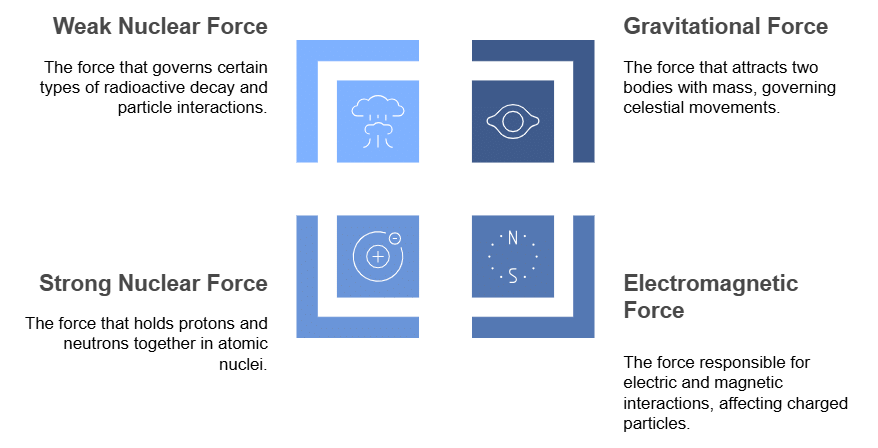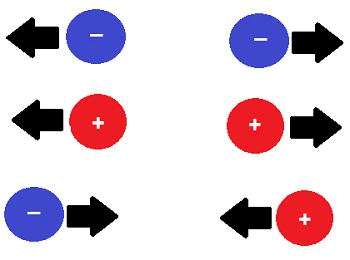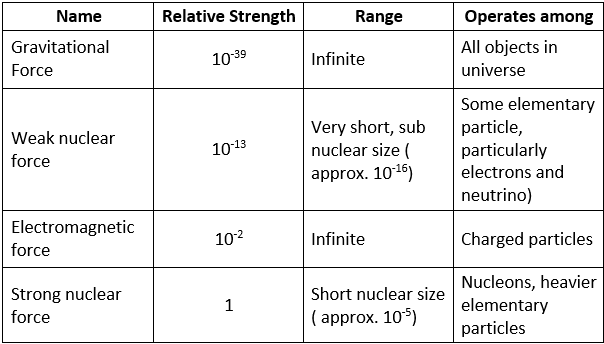Fundamental Forces in Nature | Physics Class 11 - NEET PDF Download
What are the Fundamental Forces?
The Fundamental forces, also known as Fundamental interaction, are the interactions that do not appear to be reducible to more basic interactions.
- There are four universal or fundamental forces in nature. Without these forces, all matter in the world will fall apart.
- Force as such is any pull or push that causes an object to alter its physical state (in terms of motion or deformity).

- Newton defined a force as anything that causes an object of mass ‘m’ to move with an acceleration ‘a’.
Two principle types of approaches in physics are:
1. Unification: This approach considers all of the world's phenomena as a collection of universal laws in different domains and conditions.Example: Law of gravitation applies both to an apple falling from a tree as well as the motion of planets around the sun. Electromagnetic Laws govern all electric and magnetic phenomena.

2. Reduction: This approach is to derive properties of a complex system from the properties and interaction of the constituent parts.
Example: Temperature studied under thermodynamics is also related to the average kinetic energy of molecules in the system (kinetic theory).
Following are the four fundamental forces in nature:
 Fundamental forces of Nature
Fundamental forces of Nature
1. Gravitational Force
It stated that everybody in the universe, that has mass, attracts every other body with mass with a central force which is directly proportional to the product of their masses and inversely proportional to the square of the distance between them.
- It is the weakest of the four. It is also the attractive force that arises from the gravitational interaction.
- Gravitational Force is discovered by Sir Isaac Newton in 1687 in his Principia called Universal Law of Gravitation.

Where,
- Fg is the gravitational force
- G is called the Universal Gravitational Constant and its value is experimentally determined by Henry Cavendish to be 6.67 × 10-11 Nm2/kg2
- m1 and m2 are the masses of the objects in consideration
- r is the distance between the centres of the two objects in consideration
Have you wondered why is the universe not filled with floating human beings and cows and cars and other such things?
Obviously, because the gravitational force of the earth holds us to the planet. Gravitational force is the force responsible for holding planets in their orbits and this is possible only because of their infinitely long range.
2. Electromagnetic Force
- This is the second strongest force after the strong force and it acts on electrically charged particles. It has a strength of 1/137 relative to the strong force but has an infinite range.
- However, this force has both attractive and repulsive properties due to the two charges it possesses: Negative and Positive. Like charges repel while unlike charges attract and this can be demonstrated with a simple magnet or electric charges.
 Example of Electromagnetic Force
Example of Electromagnetic Force
Did you know that you have never truly ever touched anything in the world?
You are matter, and we know that all matter is made up of atoms. Atoms in turn has a dense nucleus, protons, neutron and electrons.
And where are these electrons?
They occupy the outermost layer of an atom.
Now, what is the charge on electrons?
They have negative charges.
3. Strong Nuclear Force
- This force holds the nucleus of an atom together. It is the strongest of the forces, but it is very short-ranged.
- It acts over a range of about 10-15m, which is the average diameter of a medium-sized nucleus. This force is attractive.
- This is the most dominant force in reactions and is so strong that it binds protons with similar charges with the nucleus. It is mostly attractive in nature but can be repulsive sometimes. It has a very short range of just 1 fm.
4. Weak Nuclear Force
- This force is weak compared to the strong force as the name implies and has the shortest range of 10-18 m, which is 0.1% of the diameter of a proton.
- It is responsible for radioactive decay especially nuclear beta decay. All particles experience this force.
 Fundamental Forces of Nature
Fundamental Forces of Nature
Unification of Forces
- It is a basic quest in physics. The electromagnetic and the weak nuclear forces have now been unified and are seen as aspects of a single ‘electro-weak force. Attempts are being made to unify electro-weak and the strong force.
- Conservation of energy-momentum angular momentum charge etc. are considered to be the fundamental laws in physics. Conservation laws have a deep connection with the symmetries of nature. Symmetries of space and time and other types of symmetries play a central role in modern theories of fundamental forces in nature.
Conservation Laws in Physics
- The physical quantities that remain unchanged in a process are called Conserved quantities.
- Some of the general conservation laws in nature include the laws of conservation of energy, mass, linear momentum, angular momentum, charge, parity, etc.

- Some conservation laws are true for one fundamental force but not for the other. These conservation laws have a deep connection with the symmetries of nature.
- Symmetries of space and time and other types of symmetries play a central role in modern theories of fundamental forces in nature.
|
96 videos|367 docs|98 tests
|
FAQs on Fundamental Forces in Nature - Physics Class 11 - NEET
| 1. What are the four fundamental forces in nature? |  |
| 2. How do the fundamental forces differ from each other? |  |
| 3. What role do conservation laws play in physics? |  |
| 4. How is the strong nuclear force significant in atomic structure? |  |
| 5. Can the fundamental forces transform into one another? |  |






















